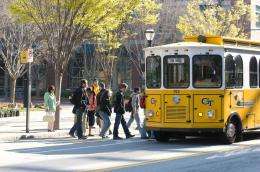Georgia Tech researchers address bus bunching

As any city dweller knows, buses are rarely on time. It’s typical to wait a while, only to have several buses show up one after another, a phenomenon known as bus bunching.
Fortunately, researchers and students at the Georgia Institute of Technology have developed a possible solution for bus bunching that provides better service to riders, simplifies the job of drivers and reduces work for management.
Industrial & Systems Engineering Professor John Bartholdi and Georgia Tech alumnus Don Eisenstein (MS IE 1983, PhD IE 1992), a colleague from the University of Chicago, have devised a way of computing the delays so gaps between buses “self-equalize.”
Now an interdisciplinary team of Georgia Tech students have built a system of tablet computers to control the trolleys using the equation on Tech’s main campus route, which carries more than 5,000 passengers a day.
“Because of its simplicity, our scheme is easy to implement and easy to adapt,” said Bartholdi, who is also the Manhattan Associates Chair of Supply Chain Management. “We expect it to be useful for other transportation systems with short headways, such as subway trains or airport shuttles.”
The first step toward reliable bus service, Bartholdi says, is to abandon the fixed schedule and have drivers go with the flow of traffic.
Under the “self-equalizing” plan, each bus is equipped with a GPS and cellphone. The GPS constantly reports the bus’s position to a central server. When the server recognizes the bus has reached a stop, it sends a message via cellphone telling the driver how long to wait and when to proceed.
That departure time is calculated through the “self-equalizing” equation, which changes the headway of each newly arrived bus to an average of its former headway and the headway of the trailing bus. For example, if its former headway was larger, its new headway becomes smaller. Using the equation, gaps between buses will equalize even if a bus is added or removed, or if the bus route changes.
“The equation computes a wait time for each bus arriving at a control point in such a way that gaps between buses tend to equalize,” Bartholdi said. “Exactly how that happens is the magic of the mathematics.”
When the research team tested the system on Tech’s bus line earlier this semester, the researchers received positive results and favorable reviews from bus riders and drivers.
This is a Vertically Integrated Project (VIP) at Georgia Tech, which combines students from across disciplines to solve a real-world project. The research outcomes will be published in Transportation Research Part B in May.
More information: Read more about Self-Coordinated Buses Resist Bunching here .
Provided by Georgia Institute of Technology


















